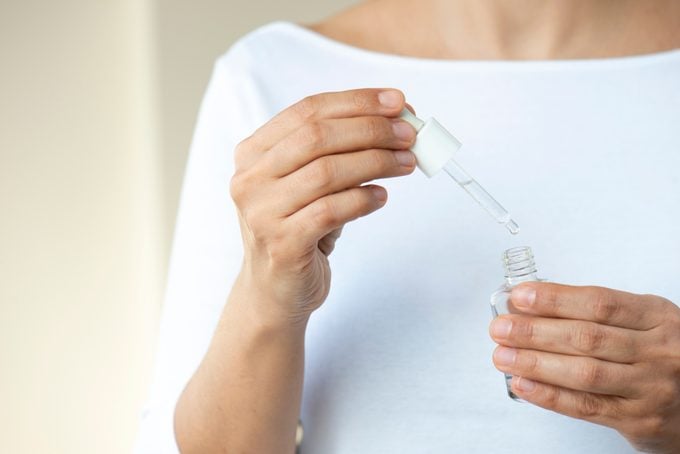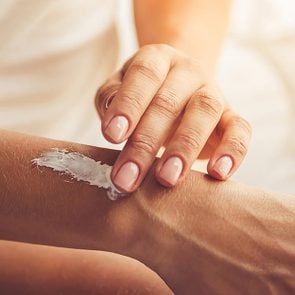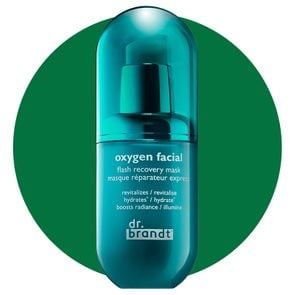How to Patch Test Skin Products to See If You’re Allergic
Updated: May 20, 2021
It can be hard to predict how your skin will react to a new skin care product, but a patch test can help you check for allergic reactions.
The importance of the patch test
Your friends won’t stop raving about it. Your Instagram feed is like a scrolling advertisement for it. And that beauty YouTuber you follow is a major fan of it.
Looks like it’s time for you to try the holy-grail skin care product you’ve been hearing so much about.
Not so fast. Before you slather it all over your face, you may want to patch test it first.
“Patch testing is important because the more specific identification of triggers can be key to treating persistent—and, on occasion, even life-threatening—allergic medical conditions,” says Jennifer M. Segal, MD, a board-certified dermatologist and founder of Metropolitan Dermatology Institute in Houston.
While it’s frustrating to wait before fully diving into your new miracle cream, patch testing can catch a whole host of issues, including potential allergic reactions and lesser (but still annoying) skin irritations.
You can use patch testing to check out makeup, skin creams, hair dyes, and other products, potentially identifying problem ingredients before you end up with itchy skin, rashes, blisters, or worse.
So set aside your latest beauty buy and get ready to learn the ins and outs of patch testing. Your skin will thank you.
(Check out these signs your skin care products are bad for you.)
Patch testing at home vs. in a doctor’s office
Often when you hear about patch testing, it’s referring to a DIY test you can do from the comfort of your PJs. But at-home patch testing isn’t the only option.
Patch testing at a doctor’s office is common for issues like contact dermatitis and allergies.
Which should you do? It depends on what you hope to find out, according to Marisa Garshick, MD, a board-certified dermatologist based in New York City.
“Home-based patch testing is testing a specific product in a small area, known as the repeated open application test, or the ROAT test,” she says. By contrast, patch testing in a doctor’s office tests multiple different allergens, which are individually applied as specific ingredients.
In other words, patch test at home if you want to know whether a specific product—say, a hair dye or that fancy new serum you’re dying to try—will cause a bad reaction.
Go for in-office patch testing if you want to know which skin care ingredients may cause you issues so you can avoid them when making future purchases.
The best patch testing for sensitive skin
Regardless of whether you’re testing at home or in a doctor’s office, you’re looking for signs of allergic contact dermatitis, a type four hypersensitivity reaction, Dr. Garshick says.
If you have sensitive skin, conditions such as psoriasis or eczema, or are prone to reactions, you may want to consider an in-office patch test to identify which ingredients to avoid.
“In-office patch testing is more extensive and may help detect sensitivity to a specific ingredient,” Dr. Garshick says.
Think of it this way: if you patch test a product at home, you’ll know whether that product is safe to use. If it’s not, you may not know what ingredient in the product caused the reaction. Was it the retinol, for instance, or the added fragrance?
Sensitive skin types, whose skin may react to a number of ingredients, may want to know more so they can stop wasting money on products that anger their skin.
If you tend to be reactive, testing at your doctor’s office can help you avoid potentially severe reactions, says Dr. Segal. After all, it’s impossible to predict just low serious a reaction may be for any given product.
“The more severe the allergic reaction—skin or otherwise—the more critical specific and accurate patch testing is to correctly identify the triggers, and also that it be done under the care of an experienced medical professional who can not only correctly interpret the response but also manage the severity of the response, if needed,” she says.
What to expect from an in-office allergy patch test
“A dermatologist’s office patch test for contact dermatitis and allergies consist of your doctor asking for a thorough lifestyle and medical history: asking about eating habits, past illnesses, et cetera,” says Lucy Chen, MD, a board-certified dermatologist at Riverchase Dermatology in Miami.
On the day of your test, the dermatologist or allergist will tape various chemicals to your upper back for 48 hours. You’ll need to avoid swimming, activities that cause sweating, and bathing.
“When you return for your next appointment, the dermatologist will remove the patches and examine your skin to see if there was an allergic response,” she says.
Your dermatologist may advise you on certain medicines to avoid before your patch test, Dr. Chen says. Follow-up visits to check for delayed reactions are common.
(Here’s what you need to know about at-home allergy tests.)
Who should patch test products?
If your skin reacts to most products, you’ll definitely want to patch test before trying something new.
“Those with psoriasis or sensitive skin should get an in-office patch test to identify an allergy before you fully expose your skin to products to prevent damaging or irritating the skin,” says Dr. Chen.
Already tried testing at your doctor’s office but didn’t get definitive results? “At-home patch testing may be helpful for someone who had in-office patch testing with weak results to determine if the specific product is the culprit,” explains Dr. Garshick.
Maybe you pride yourself on unflappable skin that barely flakes with retinol use and soaks up glycolic acid with nary a reaction. Patch testing might not be highest on your list of skin care concerns.
But just because you don’t have sensitive skin doesn’t mean you should forgo it altogether.
“Anyone can patch test a new product by applying a small amount of the product to the inside of the arm for 24 hours to see if a reaction occurs,” says Dr. Segal. “As a dermatologist with sensitive skin myself, I am always in favor of this.”
Since patch testing is so easy (more on that in a minute), it’s worth doing every time you try a new skin care product.

Where do you patch test?
The skin you choose to test on will differ based on whether you’re patch testing at home or in a doctor’s office, says Dr. Segal.
In-office patch testing usually happens on your back—it provides a wide surface area, says Dr. Garshick. At-home patch testing, on the other hand, usually takes place on areas like the inner arm, just behind an ear, or on the side of the neck.
These areas of skin tend to be thinner, which may be similar to facial skin. Plus, they’re less visible in case a reaction should occur.
Regardless of the area, there are a few hard and fast rules. “No matter where you select, it is important that the skin is clear and doesn’t have any other rashes present, as this can impact the appearance of the results,” says Dr. Garshick.
It’s also important to make sure your skin is clean and dry, with no products on it—including body lotion, butter, or oil.
(These are secrets your skin wishes you knew.)
How to do an at-home patch test
If you’re heading into your doctor’s office for patch testing, your doctor will guide you through it. At home, you’re on your own. Don’t worry—we’ve got you covered. Here’s a step-by-step guide to patch testing.
Use a dime-sized amount of product
Dr. Segal recommends testing on a one-inch-by-one-inch area of your inner arm, which roughly equates to a dime-sized amount of product.
Test for a week
In-office patch testing differs from at-home testing in a variety of ways, but most notably because you’ll have to return to your doctor’s office 24 to 48 hours later.
At home, it’s best to apply the products to the exact same location twice daily for a week, says Dr. Garshick.
Look for a reaction
Each day, check for a reaction. Allergic reactions and ingredient sensitivities might appear as redness, rashes, itchiness, or scaly, flaky, or blistered skin.
“If by the end of the week there is no reaction, it is unlikely that there is an allergy to the product,” says Dr. Garshick.
Don’t rinse it off
Rather than washing the product off your skin, keep it on after application to help see if a reaction develops.
If you’re testing a shampoo or a cleanser, however, you can rinse off as normal.
Avoid steroids
If you have eczema, avoid taking oral steroids when doing testing, says Dr. Garshick. They may mask a reaction.
“Other supplements that may be used in the treatment of eczema may be considered OK to continue to use for overall management of skin health.”
However, as always, consult your doctor first.
Products most likely to cause reactions
While certain ingredients are notoriously more irritating or allergenic than others, even the most basic products can theoretically cause a reaction in anyone.
The list of ingredients that might cause reactions is practically enough to fill a book. “It’s a very, very, very long list,” says Dr. Segal. “But fragrances and perfumes are the most frequent culprits.”
You’ll also want to be extra careful with products containing ingredients such as dyes or certain preservatives.
Dr. Garshick name-checks preservatives including methylisothiazolinone, formaldehyde, propylene glycol, and Cocamidopropyl betaine.
Keep in mind, there’s a difference between skin reactions caused by irritants and those caused by allergens.
Irritants, when applied in large enough quantities, can cause a reaction in anyone, says Dr. Garshick.
Allergens, however, will only cause reactions in people who are allergic. But it can cause a response with only a small amount of product.
Dr. Chen cites sulfates such as sodium laurel sulfate and sodium laureth sulfate as common triggers. And she says people with sensitive skin may react to retinol, benzoyl peroxide creams, and glycolic acid.
What to do if you have a reaction
You’ve done your patch testing. You’ve spotted redness or a rash. Now what?
“If you have a reaction, it is best to speak with your board-certified dermatologist to review the next steps and determine if the reaction is relevant,” says Dr. Garshick. “For example, some people may experience a reaction to an ingredient, but it may not be relevant for the type of rash they had experienced.”
She also points out that some allergies may have something called cross reactivity, “making the skin susceptible to a reaction from another possible ingredient as well.”
Healing ointments may help soothe your skin but (you know the drill!) check with your doctor first.
In some cases, reactions can be severe, which is why Dr. Segal is in favor of testing in-office.
“Reactions can be very severe, and if one experiences a strong allergic reaction, they should immediately contact their doctor and, if [they have] any swelling or difficulty breathing, call 911 for acute medical attention,” she says.
Next, these are the skin care rules to live by for every stage of life.



